Related Research Articles
Ballard MacDonald was an American lyricist, who was one of the writers of Tin Pan Alley.
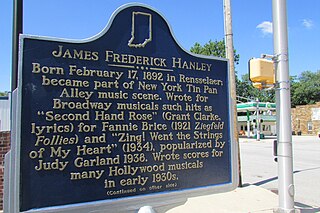
James Frederick Hanley was an American songwriter and author.
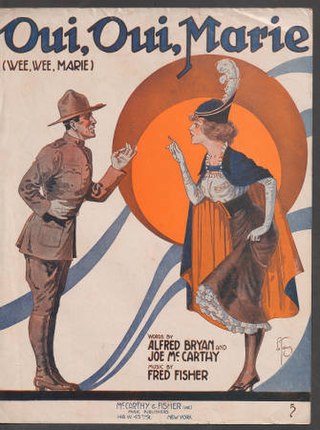
Oui, Oui, Marie is a 1918 song composed by Fred Fisher with lyrics written by Alfred Bryan and Joe McCarthy. It was published by McCarthy & Fisher Inc. The sheet music cover featured an illustration by Andre De Takacs. The song was in the top 20 charts from September 1918 to February 1919 and reached number 10 in December. It was recorded by Arthur Fields, Irving Kaufman, and Rachel Grant & Billy Murray. The sheet music can be found at the Pritzker Military Museum & Library.

The cover has George Washington, Betsy Ross, and her helper.

"Gee! What a Wonderful Time We'll Have When the Boys Come Home" is a World War I era song released in 1917. Lyrics and music were written by Mary Earl. The song was published by Shapiro, Bernstein & Co. of New York, New York. It was written for both voice and piano. The sheet music cover was designed by artist Albert Wilfred Barbelle. On the cover are soldiers marching down a city street. A skyline is behind them, and the lights spell out, "Welcome Home."
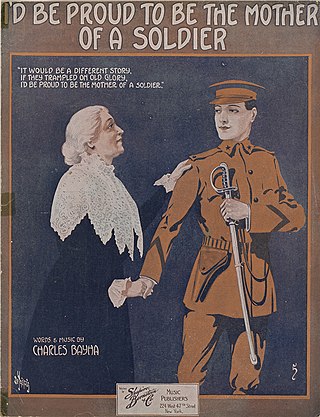
I’d be proud to be the Mother of a Soldier is a World War I song released in 1915. It was published by Shapiro, Bernstein & Co. in New York, New York.

Dear Old Pal of Mine is a World War I song written by Harold Robe and Gitz Rice. The song was first published in 1916 by G. Ricordi & Co. in New York, NY.

"Daddy Mine" is a World War I song released in 1918. Lew Wilson wrote and Alfred Dubin composed this ballad. It was published by M. Witmark & Songs in New York, New York. It was written for both voice and piano.

General Pershing: is a march composed in 1918 by Carl D. Vandersloot and published by Vandersloot Music Publishing Company.

"Oh! Frenchy" is a World War I song written by Sam Ehrlich and composed by Con Conrad. It was published in New York, New York by Broadway Music corporation in 1918. The song was in the top 20 charts from September 1918 to March 1919 and was number 2 in October, December, and February. The sheet music cover features a soldier pictured in uniform with a woman in his heart.
"Lafayette " is a World War I song written and composed by Mary Earl, which was a pseudonym of Robert A. King. It was published in New York, New York by Shapiro, Bernstein, & Co. in 1918. The sheet music cover, illustrated by Albert Barbelle, depicts soldiers marching with fixed bayonets below a statue of Lafayette in silhouette.

Don't Cry Frenchy, Don't Cry is a 1919 song written during World War I. The lyrics were written by Sam M. Lewis and Joe Young, and the music was written by Walter Donaldson.The song was published by Waterson, Berlin & Snyder Company in New York City.
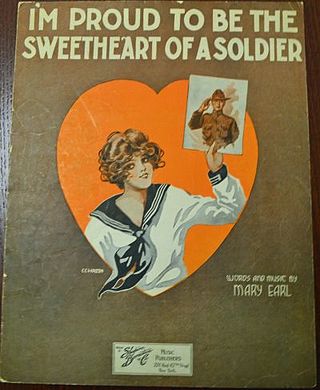
"I'm Proud to Be the Sweetheart of a Soldier" is a World War I song written and composed by Mary Earl. This song was published in 1918 by Shapiro, Bernstein & Co. Inc., in New York City. The sheet music cover, illustrated by E. E. Walton, depicts a young woman in a sailor outfit holding a picture of a soldier.

"Giddy Giddap! Go On! Go On! We're On Our Way to War" is a World War I song written and composed by Jack Frost. This song was published in 1917 by Frank K. Root & Co., in Chicago, Illinois. The sheet music cover depicts a mule pulling four soldiers in a wagon.

"Keep Your Head Down, Fritzie Boy" is a World War I song written and composed by Gitz Rice. This song was published in 1918 by Leo. Feist, Inc., in New York, NY. The cover features a photo of Gitz Rice and reads "inspired by a brave Tommy and written at the Battle of Ypres, 1915."
Salvation Lassie Of Mine is a World War I song written by Jack Caddigan and Chick Story. The song was first published in 1919 by Leo Feist, Inc. in New York, NY. The sheet music cover features a photo of a Salvation Army nurse with soldiers entering a Salvation Army hut. This song was in the top 20 charts in March and April 1919, reaching number 18 in April.
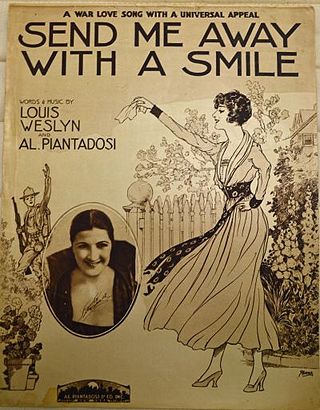
Send Me Away With A Smile is a World War I song written by Louis Weslyn and composed by Al Piantadosi. The song was first published in 1917 by Al. Piantadosi & Co., Inc. in New York, NY. The sheet music cover depicts a woman waving to a soldier from a fenced yard with an inset photo of Rita Gould.

Let's All Be Americans Now is a World War I song written and composed by Irving Berlin, Edgar Leslie, and George W. Meyer. The song was first published in 1917 by Waterson, Berlin & Snyder Co., in New York, NY.The sheet music cover depicts a soldier with his rifle and silhouetted marching soldiers in the background. A popular recording in 1917 was made by the American Quartet.
Uncle Sam and His Battering Ram is a World War I song written by Robert P. Hall and composed by Ida K. Mervine. The song was first published in 1918 by Mervine & Hall Music in Phoenix, AZ. The sheet music cover features Uncle Sam pointing to the Kaiser as a ram butts him in the stomach.
When the Flowers Bloom On No-Man's Land is a World War I song written by Howard E. Rogers and composed by Archie Gottler. The song was first published in 1918 by Kalmar, Puck, & Abrahams Music Co., in New York, NY. The sheet music cover depicts soldiers marching with an inset photo of Fred Weber. The sheet music was later reprinted with an inset photo of Dorothy Jarrett.
References
- ↑ Vogel 1995, p. 249.
- ↑ Parker 2007, p. 698.
- ↑ Paas 2014, p. 215.
- ↑ Hanley, James F.; Goodwin, Joe; MacDonald, Ballard (1918). Three wonderful letters from home. New York: Shapiro, Bernstein & Co. OCLC 71210307.
- Bibliography
- Parker, Bernard S. (2007). World War I Sheet Music. Vol. 1. Jefferson: McFarland & Company, Inc. ISBN 978-0-7864-2799-4. OCLC 71790113.
- Paas, John Roger, ed. (2014). America Sings of War: American Sheet Music from World War I. Wiesbaden: Harrassowitz Verlag. ISBN 978-3-447-10278-0. OCLC 892462420.
- Vogel, Frederick G. (1995). World War I Songs: A History and Dictionary of Popular American Patriotic Tunes, with Over 300 Complete Lyrics. Jefferson: McFarland & Company, Inc. ISBN 0-89950-952-5. OCLC 32241433.